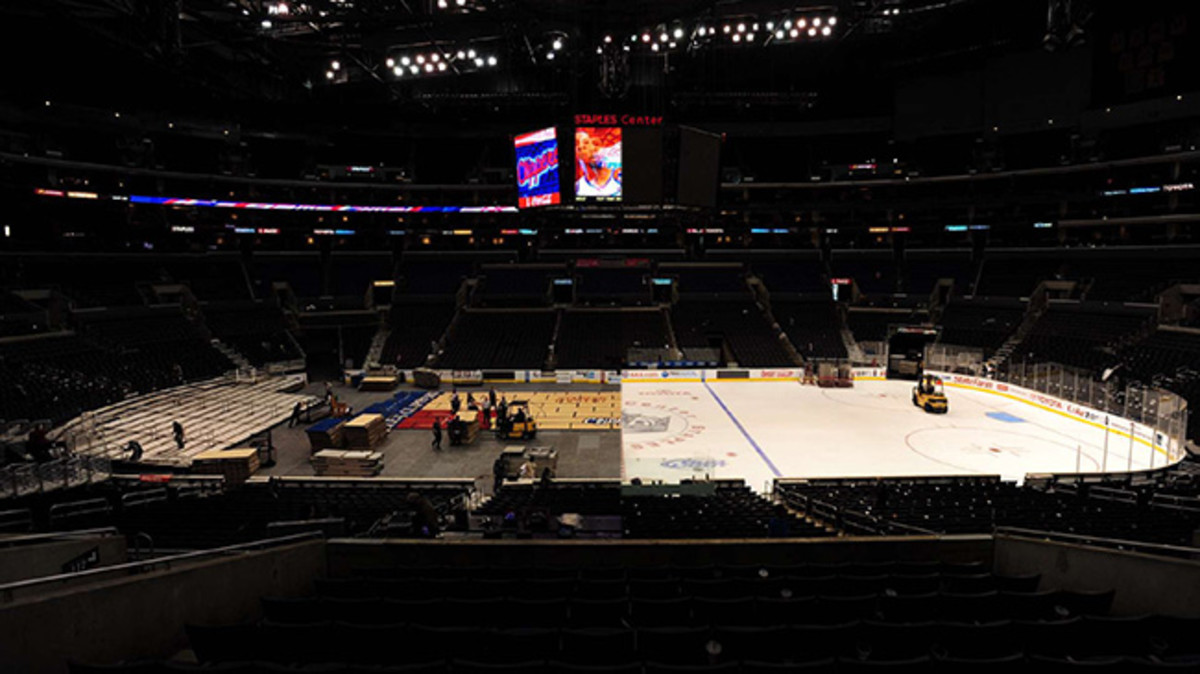How the Staples Center Swaps Rinks for Courts


When most sports fans hear the words “doubleheader,” they think of baseball teams playing two games in one day on a sunny weekend afternoon.
But for the workers at the Staples Center in Los Angeles, the term carries a much different meaning.
Staples Center is home to three professional sports teams: the Lakers and Clippers in the NBA, and the Kings in the NHL. None of those teams play two games in one day. And yet, Staples does host doubleheaders. They occur when two of these teams each play a home game on the same day.
On average, Staples hosts 10-15 doubleheaders each year. (The NBA and NHL seasons generally align with one another.) In 2016, 14 doubleheaders are scheduled. Typically, the first game starts at 12:30 p.m. and the second game can start as early as 6:30 p.m.
The challenge of hosting a doubleheader is the need to transition the entire arena from one home playing surface to another. In other words, going from basketball court to hockey rink or rink to court.
The more challenging transition is setting up a basketball game after a hockey game because the ice rink has to be covered, according to ArmenDembekjian, Director of Operations at Staples Center.
“First, the engineers have the keep the temperature at the right point at all times, so the ice does not melt,” Dembekjian says. “After that, we do have four-by-eight pieces [of covering] that we drop on the ice. Some specific areas, we’ll throw carpet on them to keep the condensation down.” From there, the basketball court is pieced together on top.
Such a conversion can take upwards of five hours with a conversion crew of 26 workers. But on a doubleheader day, the conversion must be completed within two hours and the crew is increased to approximately 60 workers.
Each worker has a specific task. There are crewmembers responsible for taking down the hockey glass around the ice rink. Some are assigned to setting up chairs around the court. Others are tasked with setting up the actual basketball court. While they’re working, four forklift drivers constantly move in and out from the storage rooms to haul in the pieces of the court.
Compared to the rink-to-court transition, setting up for hockey after basketball is a lot easier. Why? There’s no ice covering involved. But there are still challenges that can affect how smoothly the conversion is done.
“Timing is everything,” Dembekjian says about preparing for an upcoming game. “If the first game goes into overtime, double overtime, triple overtime, that takes away valuable time from us.”
With all that in mind, though, there are so many double headers every season that it feels like second nature for the crews to handle the conversions. And even though the unexpected happens from time to time, the crews are great at what they do.
During a recent hockey-to-basketball transition, “one of the seating sections got stuck,” Dembekjian remembers. “It wasn’t moving. So, five minutes before the doors open, we were finally able to move it, get it set to where it needs to be, lock it in, and have it ready to go.”
Now that’s what you call a buzzer beater!
Photos: John W. McDonough for Sports Illustrated
